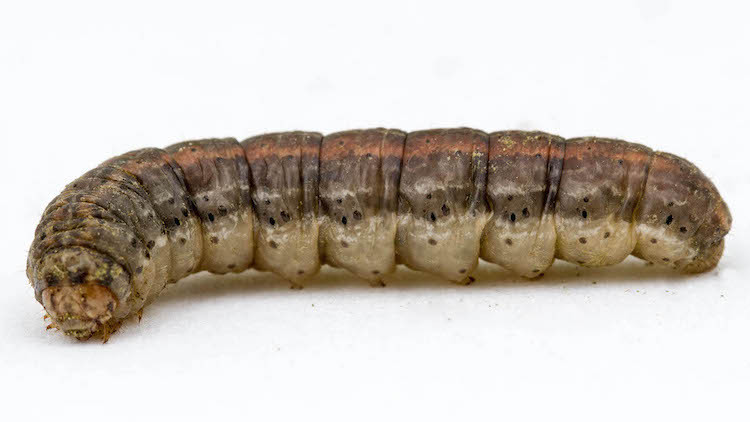Government mail service may be affected by the Canada Post labour disruption. Learn about how critical government mail will be handled.

Life cycle
There is one generation per year.
Redbacked cutworm (Euxoa ochrogaster) is primarily a pest of cereals, sugar beet, canola, mustard, and flax in the prairie provinces. It also feeds on most vegetables, sunflower, sweetclover, alsike, alfalfa, various tree seedlings and garden flowers.
Redbacked cutworm moths usually lay their eggs just below the soil surface in weedy summer fallow and in weedy patches in crops. The eggs overwinter.
Eggs usually hatch in April as soil temperatures increase. Larvae begin feeding immediately on any nearby plants and feed for 6 to 8 weeks with most of the damage occurring in June. Larvae generally remain inactive during the day, but at night either come to the surface or move underground in search of food plants.
Damage assessment
Redbacked cutworm frequently causes serious damage on the Prairies and produces infestations of two to 4 years duration followed by a minimum of two years of relative scarcity.
Damage description
Damage by young larvae is characterized by small holes and notches in foliage. Older larvae eat into stems and usually sever them at or just below the soil surface. Infestations in cereal crops are characterized by areas of bare soil that gradually enlarge until anywhere from one to two acres to complete fields are affected. Damage is often patchy and occurs on knolls and in light soil areas. These bare areas of exposed soil are often confused with areas of poor germination or moisture stress. The presence of cutworms is characterized by severed, dead, dried plants.
Sampling and monitoring methods
Redbacked cutworm moths have been monitored with pheromone traps since 1978 in southern Alberta. In 1985, a province-wide pheromone monitoring system was established for this and other cutworm species.
Sample for of larvae as for other subterranean cutworm species. Mark an area of soil 50 cm x 50 cm. During the day, larvae are within the top 5-7 cm of soil. Count the larvae within each 0.25 square metre. Repeat the process in different areas of the field. Calculate an average number of larvae per square metre for the field.
Economic thresholds
Economic thresholds are not firmly established but 5 to 6 cutworms per square metre may justify control. Well established fall-seeded or spring-seeded crops with good moisture conditions can tolerate higher numbers. Infestations may be patchy within fields. Examine the edges of bare patches to determine the cause of uneven plant distribution.
Control
Effects of weather
Augusts that are hot and dry provide the best conditions for moth feeding on flowers. Egg production and egg laying depend on the nutrition obtained from flowers. The same weather conditions promote the loose, dry soil surfaces necessary for egg deposition. Cold weather may be detrimental to larvae and pupae. Wet, warm weather promotes plant growth and fungal diseases in the larvae. Warm, dry weather can increase the severity of damage from cutworm attack.
Cultural practices
Tillage Practices - Crusted soils on summer fallow help prevent egg deposition from late July until late September. Destroy weed growth that develops in August, because redbacked cutworm moths usually lay their eggs in weedy summer fallow. They also lay in weedy patches in cereal crops and in fields of canola, peas, alfalfa and sweetclover. To starve young cutworm larvae before spring seeding, allow volunteer growth to reach 3 to 5 cm, cultivate and then seed 10 to 14 days later. Locate cutworms by digging 2 to 3 cm below the soil surface at the edge of the damaged area.
Biological control
Parasites: Natural enemies suppress outbreaks and presumably contribute to the relatively low populations that usually occur in the 2 or 3 years following outbreaks. Parasitism must be sufficiently low to permit an infestation of redbacked cutworms to develop. No parasites were found in one severe outbreak and parasite numbers were low in the year preceding an outbreak year.
Because parasite numbers tend to increase after an increase in abundance of the host, very few parasites are found during the first year of an outbreak. However, after 2 years, parasites are numerous enough to reduce the outbreak and keep cutworm numbers low for at least 2 years.
Pathogens: Heavy mortality of the larvae from disease occurs in outbreaks. In British Columbia, this pest is attacked by 18 species of parasitic insects, 5 species of fungi and 3 other kinds of microbial pathogens.